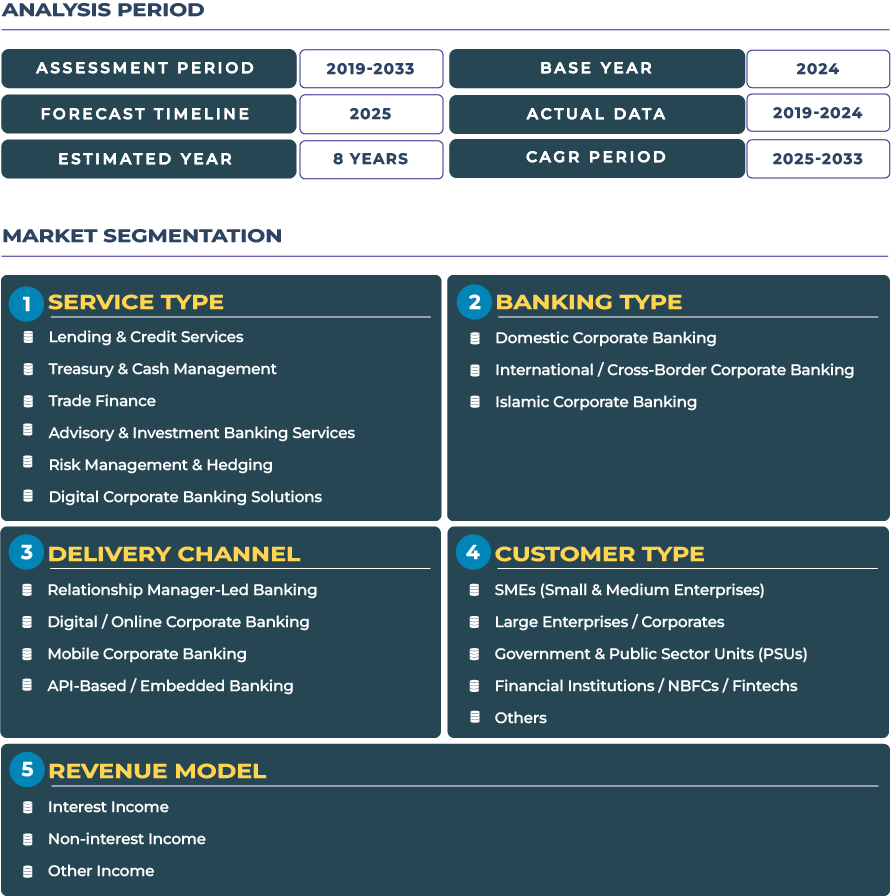Digital Trade and Corporate Finance Solutions in Chile: Streamlining Operations for Corporates
Chile corporate banking sector is embracing the convergence of trade digitization and corporate finance innovation. In a market where copper exports, mining, and commodities dominate, banks are deploying digital trade finance platforms, integrated cash management tools, and fintech-backed lending engines to support both SMEs and large corporates. With the market projected to grow from USD 12.7 billion in 2025 to USD 17.1 billion by 2033 at a CAGR of 3.8%, demand for advanced treasury and financing systems is rising steadily. Chile’s corporate banks are thereby positioning themselves as key enablers of operational efficiency, liquidity optimization, and cross-border trade enablement in a volatile commodity-driven economy.
Note:* The market size refers to the total revenue generated by banks through interest income, non-interest income, and other ancillary sources.
Market Outlook: Chile Corporate Banking Industry Anchoring Digital Trade Evolution
The corporate banking landscape in Chile is evolving from traditional credit and deposit services to a more sophisticated, digitally integrated model. Leading banks are embedding trade finance, supply-chain financing, and real-time cash management into single dashboards that communicate directly with corporate ERP systems. This enables corporates to monitor cash flows, track receivables, and manage multi-currency exposures with agility. Especially in export-reliant sectors such as mining and agriculture, these innovations are reducing working capital pressure and shortening financing cycles.
Regulatory stability and commitment to financial modernization by the Banco Central de Chile reinforce the environment for technological adoption. Additionally, global institutions such as BNP Paribas Corporate & Institutional Banking are active in Chile, providing global trade, infrastructure, and derivatives solutions that complement local corporate banking capabilities. Such global-local partnerships support advanced structuring, international cash pooling, and financing for large-scale projects, thereby raising the competitive baseline in Chile’s corporate banking ecosystem.
Drivers & Restraints: Forces Shaping Chile Corporate Banking Trajectory
Catalysts: Exporters, Green Transition, and Treasury Sophistication Propelling Growth
Chile corporate banking sector is primarily driven by its status as a top-tier exporter of copper, lithium, and other minerals. Corporates in these sectors demand trade finance, pre-export financing, and hedging solutions to manage volatility and global supply chain demands. Meanwhile, the transition toward cleaner energy and sustainable mining is attracting investments in renewable infrastructure, opening avenues for ESG-linked corporate lending. Corporates with global footprint require advanced corporate cash and treasury solutions to manage liquidity across multiple legal entities and currencies, a need that Chilean banks are responding to with API-based cash management platforms and supply-chain finance tools.
Challenges: Commodity Volatility, Limited Domestic Capital Depth, and External Shocks
The Chile corporate banking market faces structural headwinds. Its heavy reliance on commodity exports implies vulnerability to global demand fluctuations and price shocks. When copper or lithium prices fall, corporate cashflows suffer, constraining credit expansion. Chile’s domestic capital markets, though mature by regional standards, often cannot support large corporate financing fully, necessitating cross-border syndication. In times of global downturn or geopolitical turbulence, Chile’s economy is exposed to capital flow reversals, which may tighten liquidity. Banks must thus balance credit growth with robustness in capital planning and stress testing.
Trends & Opportunities: ESG Finance, Supplier Platforms, and Pre-Export Instruments
Key Trends: Green Mining Finance, Pre-Export Models, and Supplier Ecosystem Digitization
A defining trend is the growth of green mining finance. Financial institutions are launching financing lines linked to sustainable protocols, enabling mining firms to decarbonize operations while accessing preferential rates. Concurrently, pre-export copper and mineral financing is expanding as banks provide advance funding backed by export receivables. Another noteworthy trend is the use of digital supplier finance platforms in mining corridors: banks offer payables discounting, supply-chain credit, and dynamic discount protocols to vendors and contractors, creating financial inclusion deep in the supplier chain.
Opportunities: ESG Loan Issuance, Supplier Finance Uptake, and Commodity-Backed Lending
In Chile corporate banking market, strategic opportunities exist in scaling ESG-linked loan issuance, expanding pre-export credit facilities, and boosting supplier finance adoption. Banks can package structured loans tied to environmental targets, attracting global capital and aligning with corporate sustainability goals. Pre-export facilities, including for copper, lithium, and agricultural goods, offer secured credit flows aligned with global demand cycles. In addition, leveraging supplier finance across mining supply chains amplifies bank reach, improves receivables liquidity, and fosters stronger corporate ecosystems.
Competitive Landscape: Leading Banks Driving Innovation in Corporate Solutions
Key players in Chile corporate banking sector include Banco de Chile, Banco Santander Chile, BCI (Banco de Crédito e Inversiones), BancoEstado, and Itaú Corpbanca. Banco de Chile, a legacy institution with deep reach and corporate client base, is actively integrating digital treasury and trade services into its offerings. Its financial reports and strategic publications reflect prioritization of capital adequacy, liquidity, and growth in business lending. Others, such as BCI, emphasize SME lending and digital banking partnerships to broaden their reach.
Foreign institutions like BNP Paribas maintain specialized corporate desks in Chile, supporting complex project and infrastructure finance across sectors. These banks compete not just on lending, but with integrated risk, advisory, and capital market capabilities. The evolving corporate banking ecosystem in Chile is defined by how well institutions can combine local domain depth with international structuring expertise and digital platform scalability.







